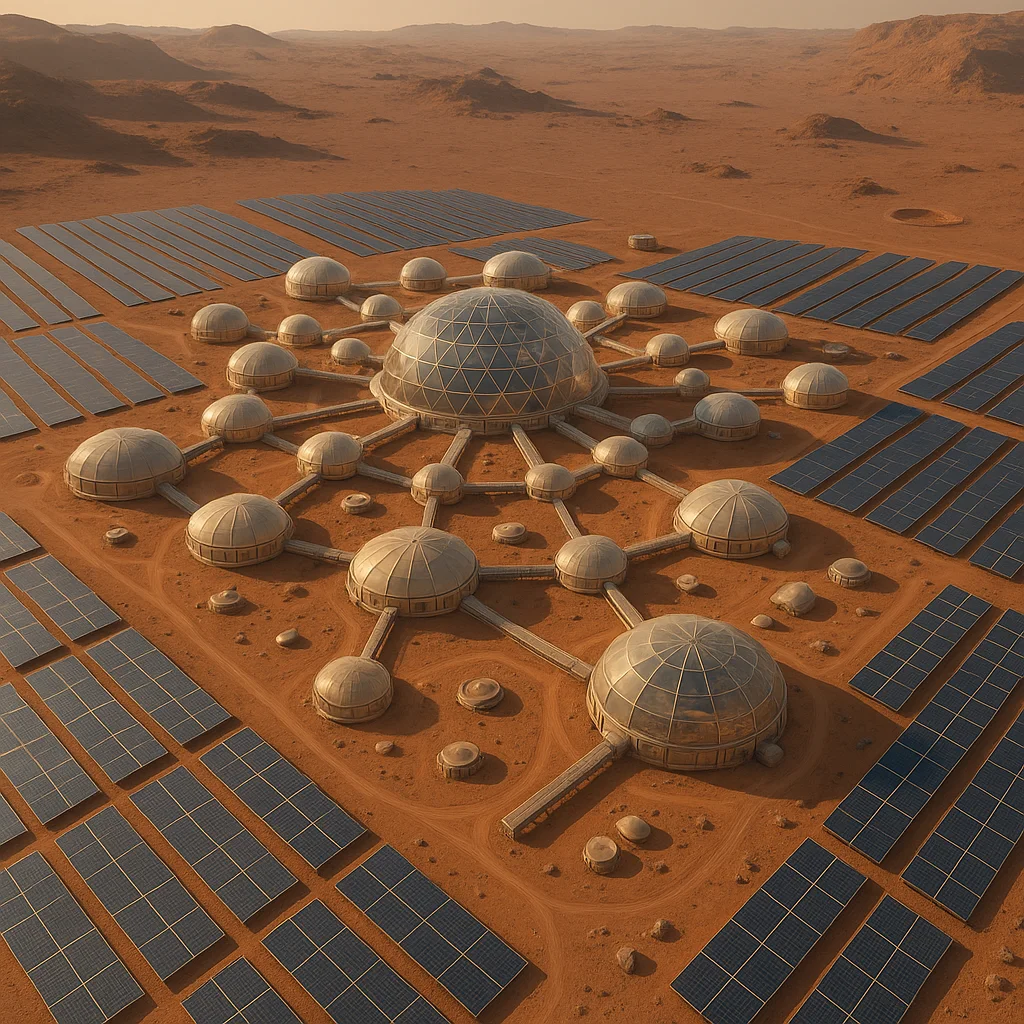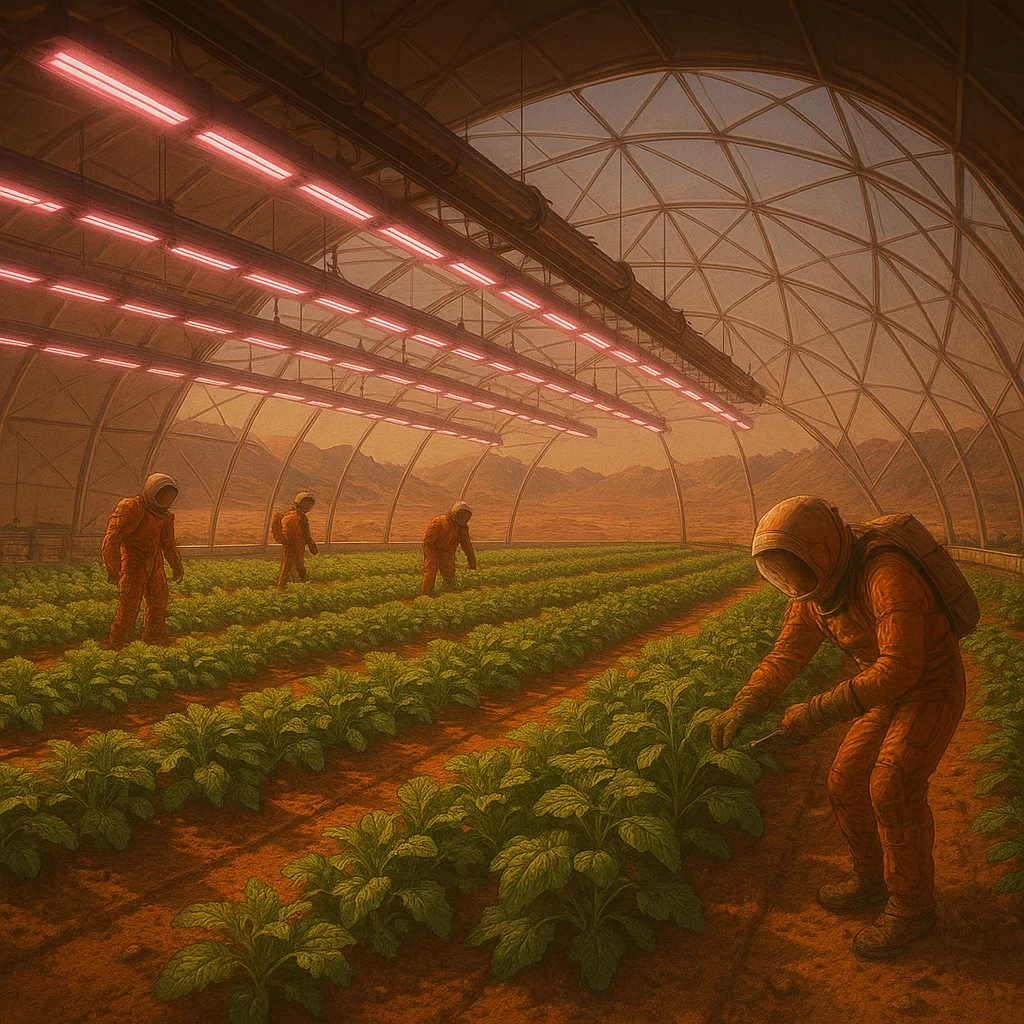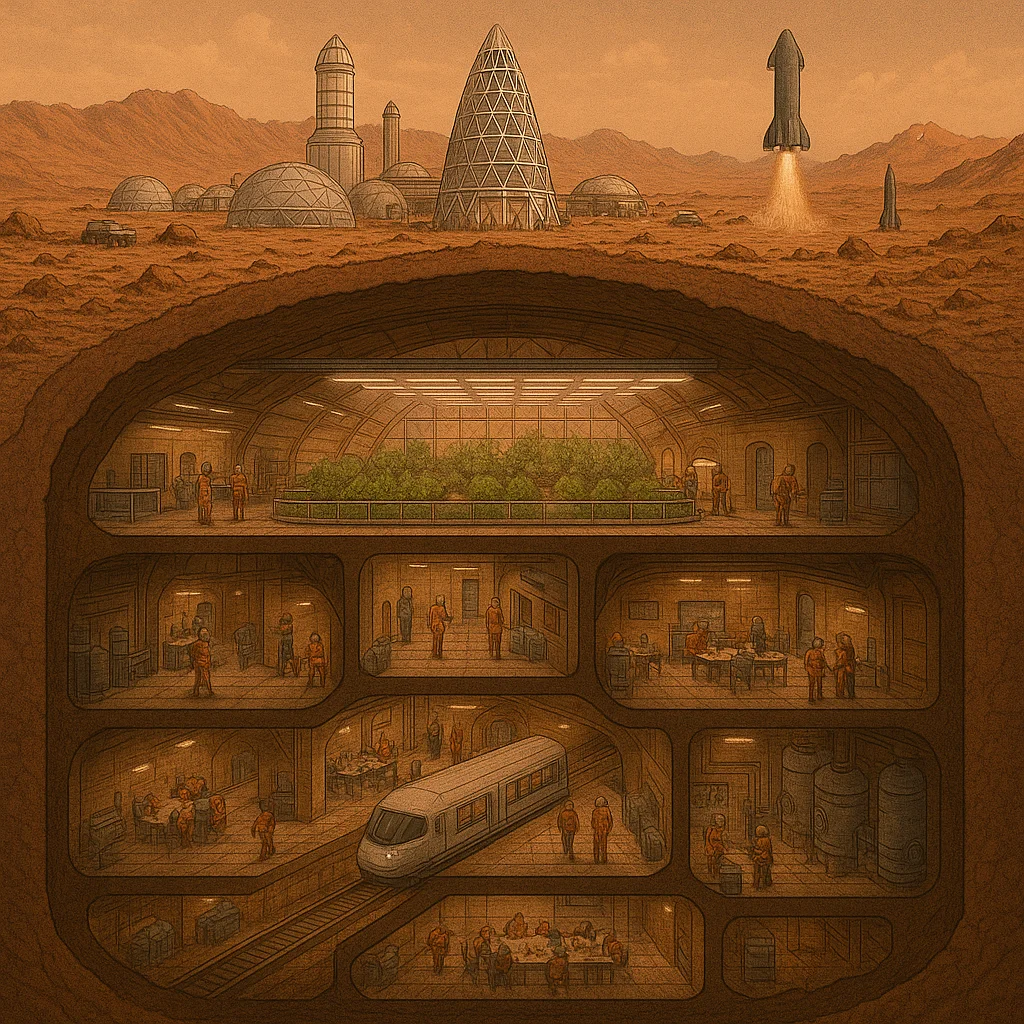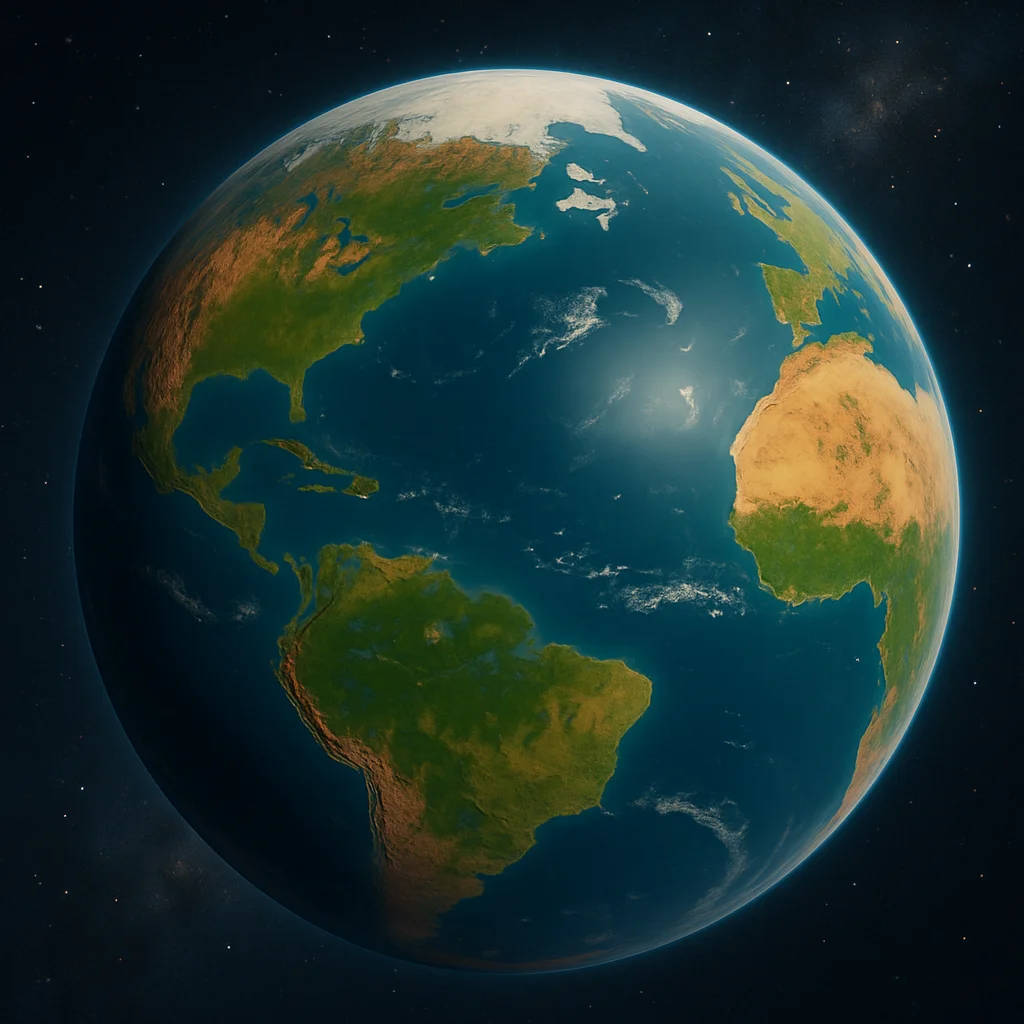In the coming decades, humanity will take its greatest leap—establishing a permanent, self-sustaining colony on Mars. This isn't just about survival; it's about creating a new branch of human civilization, complete with its own culture, economy, and perhaps one day, its own identity as Martians.

The Vision: A City of a Million
SpaceX's Elon Musk envisions a Mars city of one million people by 2050—a goal that seems audacious until you consider the exponential nature of colonial growth. The first settlements will be small, perhaps a few dozen people. But as infrastructure develops and the colony becomes more self-sufficient, growth will accelerate.
This isn't just about numbers. A million-person city represents a critical threshold:
- Genetic Diversity: Sufficient population for long-term genetic health
- Economic Complexity: Enough specialization for a modern economy
- Cultural Richness: The critical mass for arts, entertainment, and innovation
- Political Independence: The foundation for self-governance
Phase 1: The Pioneer Settlement (2030s-2040s)
The first Mars colonists will face conditions that make Antarctica look hospitable. Their primary goals will be basic survival and establishing the foundation for future growth.
Initial Infrastructure
The pioneer base will likely consist of:
- Pre-positioned Supplies: Cargo missions will deliver equipment, food, and materials before humans arrive
- Habitat Modules: Pressurized living spaces, likely partially buried for radiation protection
- Power Systems: Nuclear reactors supplemented by solar panels and batteries
- Life Support: Closed-loop systems recycling air, water, and waste
- 3D Printers: For manufacturing tools, spare parts, and eventually, building materials
"The first Martians will be the most important people in human history. They're not just explorers—they're the founders of a new world." — Robert Zubrin, Mars Society President
Daily Life for Early Colonists
Life in the early colony will be regimented and challenging:
- Work schedules dominated by maintenance, construction, and scientific research
- Limited privacy in shared habitat modules
- Rationed resources with little margin for error
- Communication delays of 4-24 minutes with Earth
- Psychological challenges of isolation and confinement
Phase 2: The Growing Settlement (2040s-2050s)
As the colony proves its viability, expansion accelerates. This phase focuses on achieving basic self-sufficiency and improving quality of life.

Agricultural Independence
Food production becomes a priority. Martian agriculture will be unlike anything on Earth:
- Pressurized Greenhouses: Using Martian soil enriched with Earth bacteria
- Vertical Farming: Maximizing yield in minimal space
- Genetic Engineering: Crops optimized for Mars conditions
- Protein Production: Insect farming, cultured meat, and algae bioreactors
Industrial Development
The colony begins producing its own materials:
- Steel Production: Using the abundant iron oxide in Martian soil
- Glass Manufacturing: From silica for windows and solar panels
- Concrete: Mars-specific formulations using local regolith
- Plastics: Initially from shipped carbon, eventually from atmospheric CO₂
Expanding Habitats
As construction capabilities grow, the colony expands beyond initial modules:
- Large pressurized domes for communal spaces
- Underground tunnels connecting different areas
- Dedicated facilities for recreation and exercise
- Private quarters for long-term residents
Phase 3: The Martian City (2050s-2070s)
With thousands of residents, the settlement transforms into a true city—the first beyond Earth.
Urban Planning for Mars
Martian cities will be designed from scratch, incorporating lessons from Earth while adapting to unique constraints:
- Centralized Design: Minimizing travel distances to conserve energy
- Redundant Systems: Multiple backups for all critical infrastructure
- Green Spaces: Parks and gardens for psychological well-being
- Mixed-Use Districts: Combining residential, work, and recreational areas

Transportation Networks
Moving around a Martian city requires rethinking transportation:
- Pressurized Walkways: Allowing shirt-sleeve movement between buildings
- Underground Metro: Protected from radiation and dust storms
- Rovers: For trips outside the pressurized zone
- Hyperloop: Potential for long-distance travel in the low-pressure environment
The Martian Economy
A self-sustaining economy emerges, initially based on:
- Research Grants: Scientific institutions funding experiments
- Tourism: Wealthy visitors experiencing another world
- Resource Export: Rare minerals or manufactured goods to Earth orbit
- Intellectual Property: Innovations developed in the unique Martian environment
Phase 4: A New Civilization (2070s and Beyond)
As the colony grows, something remarkable happens—a distinct Martian culture emerges.
Martian Society
The unique conditions of Mars will shape its society:
- Cooperation Over Competition: Survival depends on working together
- Resource Consciousness: Nothing can be wasted
- Innovation Culture: Constant problem-solving becomes ingrained
- Environmental Ethics: Terraforming debates shape political divisions
Governance and Independence
Political structures will evolve with the colony:
- Initial corporate or agency governance
- Elected councils as population grows
- Potential confederation of multiple settlements
- Eventually, calls for independence from Earth
"The American colonies declared independence over tea taxes. Imagine what Martians will think about Earth trying to govern them from 140 million miles away." — Kim Stanley Robinson, Author of the Mars Trilogy
The First Martians
Children born on Mars will be the first true Martians. They will be:
- Physically adapted to lower gravity (taller, less muscle mass)
- Psychologically shaped by the Martian environment
- Culturally distinct from Earth-born humans
- Potentially unable to visit Earth due to gravity differences
Challenges to Overcome
Medical and Biological
- Gravity: Long-term effects of 38% gravity on human physiology
- Radiation: Increased cancer risk despite shielding
- Pregnancy: Unknown effects on fetal development
- Medical Emergencies: No possibility of evacuation to Earth
Psychological and Social
- Isolation: Being months or years from Earth
- Cabin Fever: Limited outdoor access
- Cultural Drift: Growing disconnect from Earth society
- Generational Conflict: Between Earth-born and Mars-born
Technical and Logistical
- Dust: Pervasive, toxic, and damaging to equipment
- Maintenance: Everything breaks, and spare parts are precious
- Expansion: Each new module must integrate perfectly
- Communication: Time delays complicate Earth-Mars coordination
The Long-Term Vision
Beyond survival and growth lies transformation. The Mars colony represents:
A Backup for Humanity
A self-sustaining Mars colony ensures our species survives any catastrophe on Earth—from nuclear war to asteroid impacts to pandemics.
A Laboratory for Society
Mars offers a chance to experiment with new forms of governance, economics, and social organization without Earth's historical baggage.
A Stepping Stone to the Stars
Mars' lower gravity and thin atmosphere make it an ideal launch point for missions to the asteroid belt and outer planets.
The Birth of Interplanetary Humanity
The Mars colony marks our transformation from a single-planet to a multi-planet species—the first step toward spreading throughout the solar system and eventually to the stars.

Making It Real
The Mars colony isn't science fiction—it's an engineering challenge. Every technology needed exists or is in development. What remains is the will to commit resources and accept risks.
The first colonists will face hardships we can barely imagine. They'll live knowing that a single failure could kill everyone. They'll miss Earth's blue skies, running water, and the feeling of wind on their faces.
But they'll also experience something no human has before: sunrise on another world they can call home. They'll be the founders of a new branch of humanity, the ancestors of millions of Martians to come.
The Red Planet awaits. Not as a destination to visit, but as a world to inhabit, shape, and make our own. The journey begins now, with every rocket launch, every technological advance, and every person who looks up at that red dot in the night sky and thinks: "Someday, people will live there. Maybe I will be one of them."